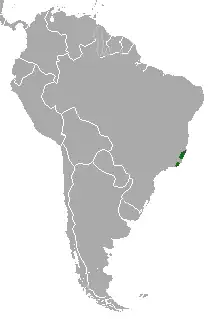Southern maned sloth
The southern maned sloth (Bradypus crinitus) is a three-toed sloth species.
| Southern maned sloth | |
|---|---|
 | |
| Scientific classification | |
| Domain: | Eukaryota |
| Kingdom: | Animalia |
| Phylum: | Chordata |
| Class: | Mammalia |
| Order: | Pilosa |
| Family: | Bradypodidae |
| Genus: | Bradypus |
| Species: | B. crinitus |
| Binomial name | |
| Bradypus crinitus Gray, 1850 | |
 | |
| Southern maned sloth range | |
Description
The southern maned sloths have flatter skulls, rounder jaws, and wider cheekbones than the northern maned sloths.[1] The species has a head that looks like a coconut.
Distribution
The sloth is endemic to Brazil's Atlantic Forest, a highly biodiverse region. Southern maned sloths were found in Rio de Janeiro and Espírito Santo.[2]
Discovery
The species was discovered by John Edward Gray in 1850, but his assertions were later dismissed, with taxonomists agreeing that the specimen, that Gray described was a B. torquatus, but the new study proves that B. critinus does indeed exist.[1] The B. crinitus separated from B. torquatus in the north by more than 4 million years of evolution.[3] B.torquatus and B. crinitus are allopatrically distributed that diverged during the Early Pliocene (period of global cooling). [[Miranda, F. R., Garbino, G. S., Machado, F. A., Perini, F. A., Santos, F. R., & Casali, D. M. (2022). Taxonomic revision of maned sloths, subgenus Bradypus (Scaeopus), Pilosa, Bradypodidae, with revalidation of Bradypus crinitus Gray, 1850. Journal of Mammalogy, 104(1), 86–103. https://doi.org/10.1093/jmammal/gyac059]]
Name
The sloth received Gray's old name, Bradypus crinitus.[3] The name crinitus means 'hairy', referring to its coconut-like head.[4]
References
- "New Species Of Coconut Headed Sloth Identified In Brazilian Jungle". IFLScience. Retrieved 2023-02-19.
- "New Animal Species Discovered | Conservation & Wildlife". 2023-01-13. Retrieved 2023-02-19.
- "Newly recognised species of sloth has a head like a coconut". New Scientist. Retrieved 2023-02-19.
- "Top 15 species discoveries from 2022 (Photos)". Mongabay Environmental News. 2022-12-29. Retrieved 2023-02-19.